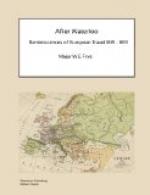In the evening we arrived at Bolsena, the ancient Volsinium, a city of the Volscians. It is an ancient looking town, not very clean, and inhabited by indolent people. It is situated on the banks of a large lake, on which there are three small islands. It is very aguish and unhealthy, and the inhabitants appear sickly, with marvellous sallow complexions. The inn where we put up was a pretty good one, and as this lake abounds in fish, we had some excellent trout and pike for supper; among other dishes there was one that was very gratifying to me, an old East and West Indian; and that was the Peveroni or large red and green peppers or capsicums fried in oil. Some excellent Orvieto wine crowned our repast, and helped to restore us from our fatigues.
On leaving Bolsena the next morning, the 7th, and within a very short distance from that town we entered a thick and venerable forest, thro’ which the road runs for several miles. Fine old trees of immense height covered with foliage and thickly studded together give to this forest an aweful and romantic appearance. It is quite a lucus opaca ingens. This forest has been held sacred since the earliest times and is even now held in such superstitious veneration by the people that they do not allow it to be cut. The Dryads and Hamadryads have no doubt long ago taken their flight, but the wood, from its length and opaqueness, inspired me with some apprehension lest it might be the abode of some modern votaries of Mercury, people having confused ideas of meum and tuum, and the appropriative faculty too strongly developed in their organization, and I expected every moment to hear a shot and the terrible cry of ferma; but we met with no accident nor did we fall in with a living soul. On issuing from this forest we perceived on an eminence before us, at a short distance, the town of Montefiascone. We stopped there as almost all travellers do to taste the famous Montefiascone wine or Est wine, as it is frequently called. This wine is fine flavored, petillant and wonderfully exhilarating. It is renowned for having occasioned the death of a German prelate in the sixteenth century, who was travelling in Italy and who was remarkably fond of good wine. The story is as follows. He was accustomed to send on his servant to the different towns thro’ which he was to pass with directions, to taste and report on the quality of the different wines to be found there, and if they were good to mark the word Est on the casks from which he tasted them. The servant, on arrival at Montefiascone, was highly pleased with the flavour of the wine, of which there were three casks at the inn where they put up. He accordingly wrote the word Est on each of the casks. The Bishop arrived soon after and took such a liking to this wine that he died in a few days of a fever brought on by continual intoxication. He was buried in one of the churches




